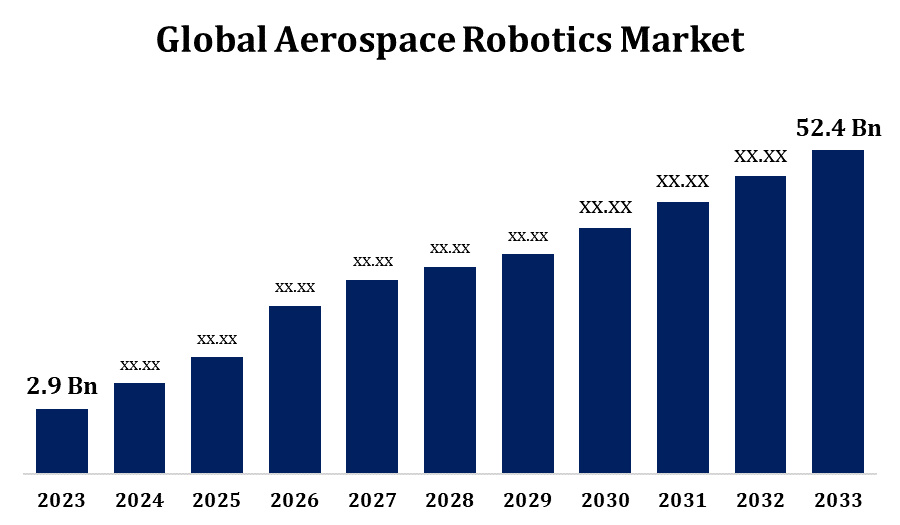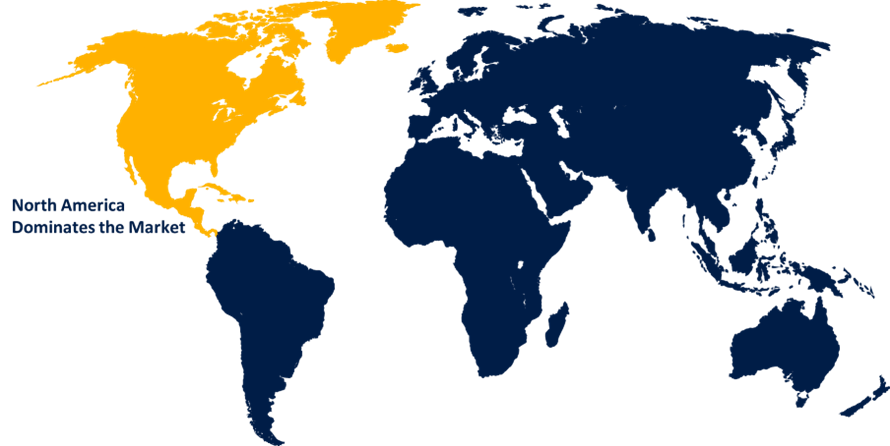Global Aerospace Robotics Market Size To Worth USD 7.31 Bllion By 2033 | CAGR 37.31%
Category: Aerospace & DefenseGlobal Aerospace Robotics Market Size To Worth USD 7.31 Bllion By 2033
According to a research report published by Spherical Insights & Consulting, the Global Aerospace Robotics Market Size to Grow from USD 2.9 Billion in 2023 to USD 52.4 Billion by 2033, at a Compound Annual Growth Rate (CAGR) of 37.31% during the forecast period.

Get more details on this report -
Browse key industry insights spread across 239 pages with 110 Market data tables and figures & charts from the report on the “Global Aerospace Robotics Market Size, Share, and COVID-19 Impact Analysis, By Application (Material Handling, Surface Treatment, Composites Applications, Assembly, and Others), By Technology (Conventional, Collaborative), By Solution (Hardware, Software, and Services), and By Region (North America, Europe, Asia-Pacific, Latin America, Middle East, and Africa), Analysis and Forecast 2023 – 2033.” Get Detailed Report Description Here:https://www.sphericalinsights.com/reports/aerospace-robotics-market
The aerospace robotics market is expanding rapidly, owing to advances in automation technologies, increased demand for aircraft production, and stringent safety requirements. These robots are used in a variety of applications, including drilling, welding, painting, and assembling, increasing efficiency and precision while reducing production time and costs. Key market participants are constantly investing in R&D to produce breakthrough robotic solutions capable of performing complicated tasks with high precision. Furthermore, the use of robotics in maintenance, repair, and overhaul (MRO) operations is accelerating market growth.
Aerospace Robotics Market Value Chain Analysis
The aerospace robotics market value chain consists of several stages, ranging from raw material acquisition to the final delivery of robotic systems and services. Initially, suppliers contribute materials such as metals, electronics, and software components. Manufacturers then design, build, and integrate these components to create robotic systems specifically for aircraft applications. Distributors play an important role in promoting and selling these systems to end users such as aircraft manufacturers, maintenance facilities, and research organisations. Service providers provide installation, training, maintenance, and technical support to ensure that robotics work optimally throughout their lives. Furthermore, stakeholders such as regulatory organisations and industry associations help by setting standards and pushing technology improvements.
Aerospace Robotics Market Opportunity Analysis
The aerospace robotics industry offers numerous prospects, which are driven by a variety of variables. To begin, the growing demand for aircraft in the commercial, military, and space sectors necessitates innovative automation systems to improve manufacturing efficiency and meet high quality standards. Furthermore, the growing emphasis on lowering operational costs and enhancing safety in aerospace production processes creates a favourable climate for the use of robotics. Furthermore, the emergence of new technologies such as artificial intelligence, machine learning, and collaborative robots has increased the capabilities and uses of aerospace robotics. Furthermore, the growing trend of automation in maintenance, repair, and overhaul (MRO) activities provides an additional opportunity for market expansion.
Several factors contribute to these investments, including an increase in demand for automation solutions in aircraft manufacturing and maintenance processes. Aerospace firms are investing heavily in advanced robotic technologies to improve efficiency, precision, and safety. Furthermore, the incorporation of robotics enables manufacturers to meet rising demand for aeroplanes while maintaining high quality standards. Furthermore, improvements in robotics, such as artificial intelligence and collaborative robots, are drawing additional investment by providing improved capabilities and versatility in aircraft applications. Furthermore, the increased emphasis on sustainability and lowering carbon footprints in aerospace manufacturing is encouraging investment in robots to improve resource utilisation and reduce waste.
The aerospace robotics market has various hurdles that prevent widespread deployment. One of the most substantial upfront investments is necessary to integrate robotic technologies in aerospace manufacturing and maintenance operations. Customisation charges and integration challenges exacerbate this issue, limiting access for some organisations. Furthermore, cybersecurity flaws in robotic systems generate concerns about data privacy and infrastructure security, hindering adoption attempts. The aircraft industry's stringent regulatory standards enforce strict safety and quality requirements, necessitating meticulous compliance efforts. Furthermore, a lack of experienced workers knowledgeable in robotics and automation technologies hinders the full potential of aerospace robotics.
Insights by Application
The composites segment accounted for the largest market share over the forecast period 2023 to 2033. Composites provide substantial advantages in aircraft applications due to their lightweight, high strength-to-weight ratio, and corrosion resistance. Aerospace manufacturers are increasingly relying on composite materials to reduce aircraft weight, improve fuel efficiency, and boost overall performance. Robots play an important part in the production, assembly, and inspection of composite components, assuring precision and efficiency in manufacturing operations. Furthermore, advances in robotic technology, such as automated fibre placement and robotic composite layup, allow complicated composite structures to be manufactured with high accuracy and repeatability.
Insights by Technology
The collaborative technology segment is dominating the market with the largest market share over the forecast period 2023 to 2033. Collaborative robots, or cobots, are increasingly being used in aerospace production activities because of their ability to work alongside human operators without the use of safety barriers. This strong collaboration improves productivity and safety while streamlining production procedures. Cobots thrive in jobs like assembly, inspection, and material handling, especially in circumstances where accuracy and flexibility are critical. Furthermore, advances in sensor technology and artificial intelligence enable these robots to adapt to changing production settings and accomplish difficult jobs with ease. As aircraft firms prioritise productivity and manage labour shortages, the deployment of collaborative technologies continues to accelerate, resulting in considerable development in the aerospace robots industry.
Insights by Solution
The hardware segment is dominating the market with the largest market share over the forecast period 2023 to 2033. Aerospace robotics hardware consists of numerous components and systems, including robotic arms, end-effectors, sensors, controllers, and peripherals. As the aerospace sector increasingly uses automation and robots to improve manufacturing processes, there is a growing demand for advanced hardware solutions specifically designed for aerospace applications. Manufacturers are investing in R&D to improve the performance, durability, and reliability of robotics hardware, assuring optimal functionality in harsh aerospace environments. Furthermore, advances in materials, sensor technologies, and control systems are fueling innovation in aerospace robotics hardware, allowing for more precise, efficient, and varied operations.
Insights by Region

Get more details on this report -
North America is anticipated to dominate the Aerospace Robotics Market from 2023 to 2033. The region has a strong aerospace sector, with significant firms such as Boeing and Lockheed Martin, which drives demand for advanced automation solutions to improve manufacturing efficiency and competitiveness. Furthermore, increased investments in R&D, particularly in new technologies like artificial intelligence and collaborative robots, are driving innovation in aircraft robotics. Furthermore, the presence of a well-established network of robotics-focused vendors and service providers helps to drive market growth.
Asia Pacific is witnessing the fastest market growth between 2023 to 2033. The growing aerospace industry in China, Japan, and India, together with increased expenditures in automation and robotics, is driving demand for advanced robotic systems. Rising aircraft production rates, fueled by increased air travel demand and defence modernization projects, are accelerating market growth. Furthermore, government initiatives to promote technological innovation and industrial automation are boosting the regional aerospace robotics industry. However, issues such as the necessity for qualified labour and worries about intellectual property protection remain. Despite these obstacles, the Asia Pacific aerospace robotics market is poised for significant expansion, utilising the region's thriving aerospace sector and increased emphasis on automation to boost global innovation and competitiveness.
Recent Market Developments
- In July 2021, Fanuc Corporation stated that it has begun manufacture of its 750,000th industrial robot, a record high in the robotics sector.
Major players in the market
- Kuka AG
- ABB Group
- Fanuc Corporation
- Yaskawa Electric
- Kawasaki Heavy Industries
- Mtorres
- Oliver Crispin Robotics
- Gudel Ag
- Electroimpact Inc.
- Universal Robots A/S
- Swisslog Ag
- Reis Robotics
- Boston Dynamics
- Bosch Rexroth
Market Segmentation
This study forecasts revenue at global, regional, and country levels from 2023 to 2033.
Aerospace Robotics Market, Application Analysis
- Material Handling
- Surface Treatment
- Composites Applications
- Assembly
- Others
Aerospace Robotics Market, Technology Analysis
- Conventional
- Collaborative
Aerospace Robotics Market, Solution Analysis
- Hardware
- Software
- Services
Aerospace Robotics Market, Regional Analysis
- North America
- US
- Canada
- Mexico
- Europe
- Germany
- Uk
- France
- Italy
- Spain
- Russia
- Rest of Europe
- Asia Pacific
- China
- Japan
- India
- South Korea
- Australia
- Rest of Asia Pacific
- South America
- Brazil
- Argentina
- Rest of South America
- Middle East & Africa
- UAE
- Saudi Arabia
- Qatar
- South Africa
- Rest of the Middle East & Africa
About the Spherical Insights & Consulting
Spherical Insights & Consulting is a market research and consulting firm which provides actionable market research study, quantitative forecasting and trends analysis provides forward-looking insight especially designed for decision makers and aids ROI.
Which is catering to different industry such as financial sectors, industrial sectors, government organizations, universities, non-profits and corporations. The company's mission is to work with businesses to achieve business objectives and maintain strategic improvements.
CONTACT US:
For More Information on Your Target Market, Please Contact Us Below:
Phone: +1 303 800 4326 (the U.S.)
Phone: +91 90289 24100 (APAC)
Email: inquiry@sphericalinsights.com, sales@sphericalinsights.com
Contact Us: https://www.sphericalinsights.com/contact-us
Need help to buy this report?